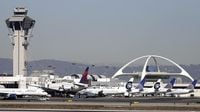Travelers hoping for a smooth Sunday morning at Los Angeles International Airport (LAX) on October 26, 2025, found themselves caught in a web of confusion, delays, and conflicting information after a staffing shortage in Oakland’s air traffic control center triggered a temporary ground stop. What exactly happened, and why did it cause such widespread uncertainty? Let’s unpack the events, the official responses, and the broader context that’s left many wondering about the state of America’s air traffic system.
According to an advisory from the Federal Aviation Administration (FAA), a ground stop order went into effect at approximately 8:27 a.m. Pacific Time, impacting flights departing from airspace managed by both the Los Angeles and Oakland air traffic control centers that were scheduled to arrive at LAX. The order, first reported by the FAA’s Air Traffic Control System Command Center, was expected to last until 10 a.m., with a medium chance of extension. Los Angeles World Airports (LAWA) confirmed that the stoppage began around 8:45 a.m., urging passengers to check with their airlines for updates on delays or cancellations.
But the story quickly became more complicated. As reported by The Associated Press and picked up by numerous outlets, the FAA initially stated that all flights bound for LAX would be held in their city of origin due to an air traffic controller shortage. However, when Straight Arrow News reached out to LAX for clarification, the airport’s public information officer (PIO) offered a different perspective. “This morning, the FAA issued a ground stop from LA to Oakland Airport,” the PIO explained, emphasizing that the stop was due to staffing issues in Oakland, not Los Angeles. “I can only comment on LAX, of course, but that is what I heard.”
While the FAA’s website noted the possibility of ground stops and delays at LAX extending until 3 p.m. Central Standard Time, the official flight tracker for LAX didn’t appear to show widespread interruptions. Some outlets reported that delays, averaging an hour and forty minutes, began at 11:42 a.m. Eastern Time, but other sources cited shorter average delays of about 49 minutes, with some flights waiting as long as 87 minutes. By 10:30 a.m. Pacific Time, LAX officials confirmed the stoppage had been lifted, attributing the disruption to a staffing issue in Oakland. Importantly, only flights between Los Angeles and Oakland were affected; no other airports were impacted, according to LAX spokespersons.
The confusion didn’t stop there. Passengers and media outlets scrambled to make sense of the conflicting reports. Some believed all LAX-bound flights were halted, while airport officials insisted the impact was limited to a specific route. The PIO at LAX clarified that air traffic control operations are divided into geographic zones, meaning issues at one airport can potentially affect others in the same region. “I did hear that because it’s by zone, the airspace that they shut down, that maybe some neighboring airports were having some issues as well,” the PIO told Straight Arrow News, though they could only officially speak for LAX.
Behind the scenes, the root of the problem was no secret: a chronic shortage of air traffic controllers, exacerbated by the ongoing government shutdown, now entering its fourth week. Since early October, reports indicated that about 10% of the nation’s air traffic controllers were calling in sick. The strain on the system has been mounting, with disruptions and delays becoming more frequent across the country. On the same Sunday as the ground stop, Transportation Secretary Sean Duffy appeared on Fox News to warn of even more dire consequences. "Come Tuesday, paychecks will stop for roughly 13,000 air traffic controllers across the country," Duffy stated, highlighting the looming financial pressure on a workforce already stretched to the limit.
The government shutdown’s ripple effects have been felt in airports large and small. Staffing shortages have led to longer wait times, delayed flights, and increased stress for both travelers and employees. The FAA, responsible for managing the nation’s complex web of airspace, has struggled to maintain normal operations as more controllers are absent or working without pay. According to the FAA’s own data, Sunday’s ground stop resulted in more than 900 total delay minutes, with some flights experiencing significant holdups.
For those flying between Los Angeles and Oakland on October 26, the morning’s events were a stark reminder of just how fragile the nation’s air travel infrastructure can be. The halt began at LAX around 8:45 a.m. and was lifted shortly before 11 a.m., with officials repeatedly attributing the disruption to staffing shortages in Oakland. No additional details were immediately available, but the incident underscored the interconnectedness of the air traffic system: a shortage in one control center can ripple outward, affecting flights hundreds of miles away.
The broader context is sobering. America’s air traffic controllers are responsible for the safety of millions of passengers each day, yet the profession has faced a staffing crisis for years. The ongoing government shutdown has only made matters worse, with reports of increased absenteeism and mounting financial hardship for those still on the job. As one LAX official put it, "Air traffic control operations are segmented into geographic zones, so issues at one airport could affect neighboring airports in the same zone." That interconnectedness, while usually a strength, becomes a vulnerability when resources are stretched too thin.
For travelers, the advice remains the same: check with your airline before heading to the airport, especially during periods of uncertainty. For air traffic controllers, the coming days and weeks promise more challenges, as the shutdown drags on and paychecks stop arriving. And for policymakers, Sunday’s events offer yet another warning about the consequences of underfunding and political gridlock in critical sectors of the economy.
By midday on October 26, flights between Los Angeles and Oakland were moving again, and the immediate crisis had passed. But the underlying issues—staffing shortages, government shutdowns, and the fragility of the nation’s air traffic system—remain unresolved. As the country heads into another week of uncertainty, travelers and industry insiders alike are left hoping for a return to normalcy, but bracing for more turbulence ahead.




